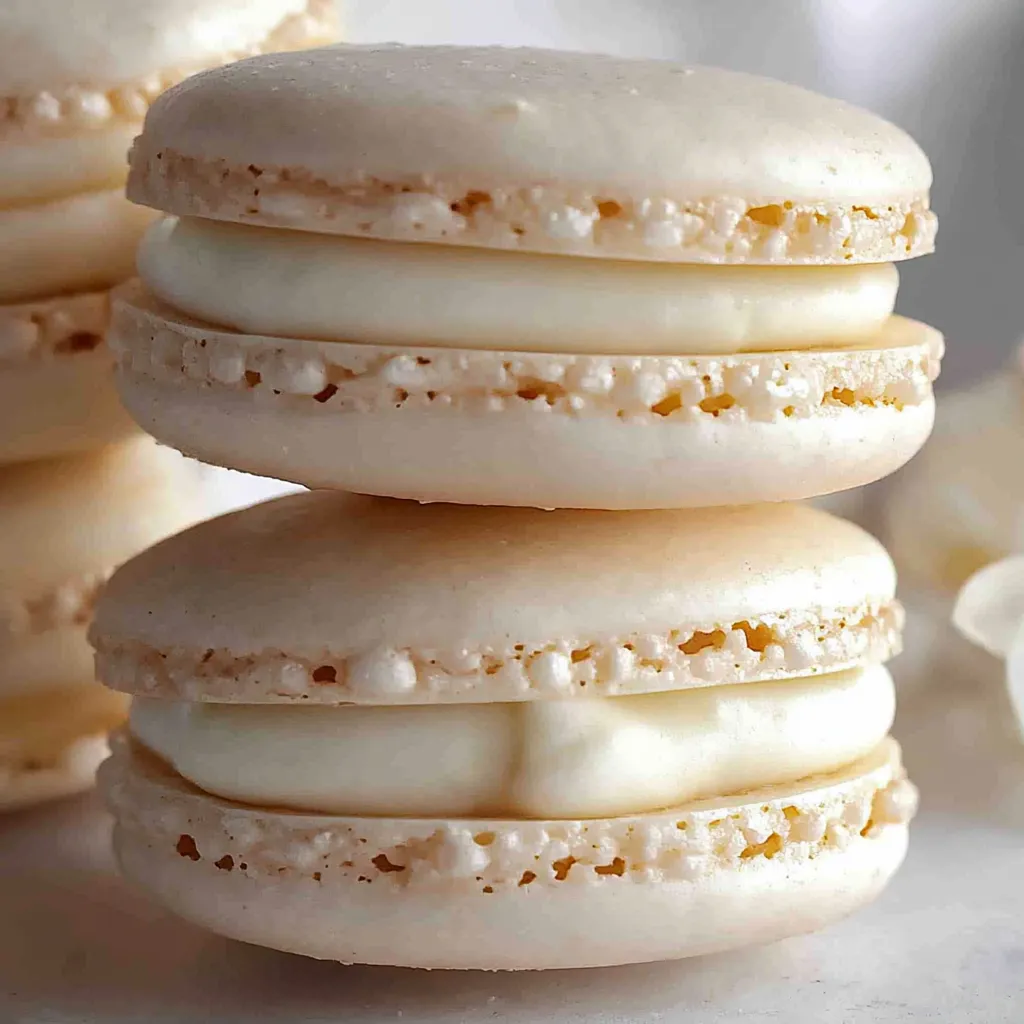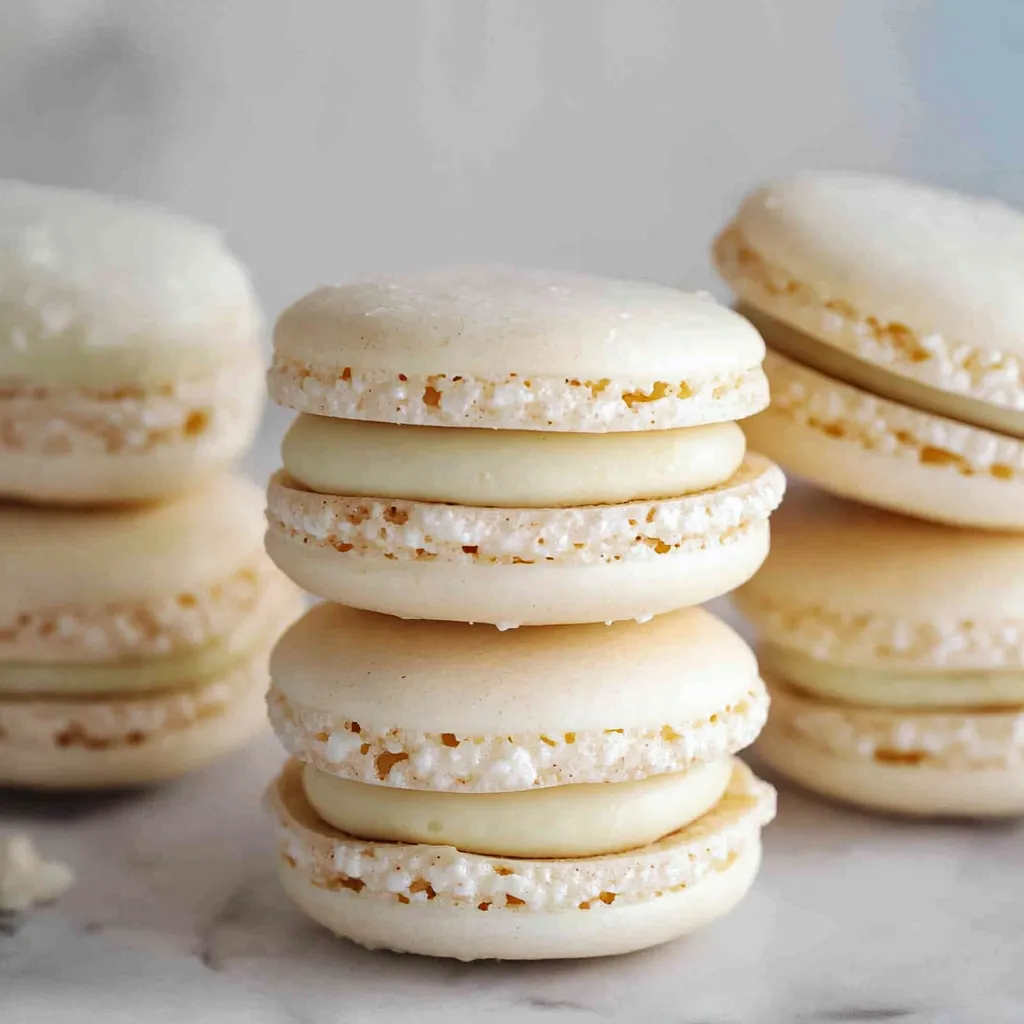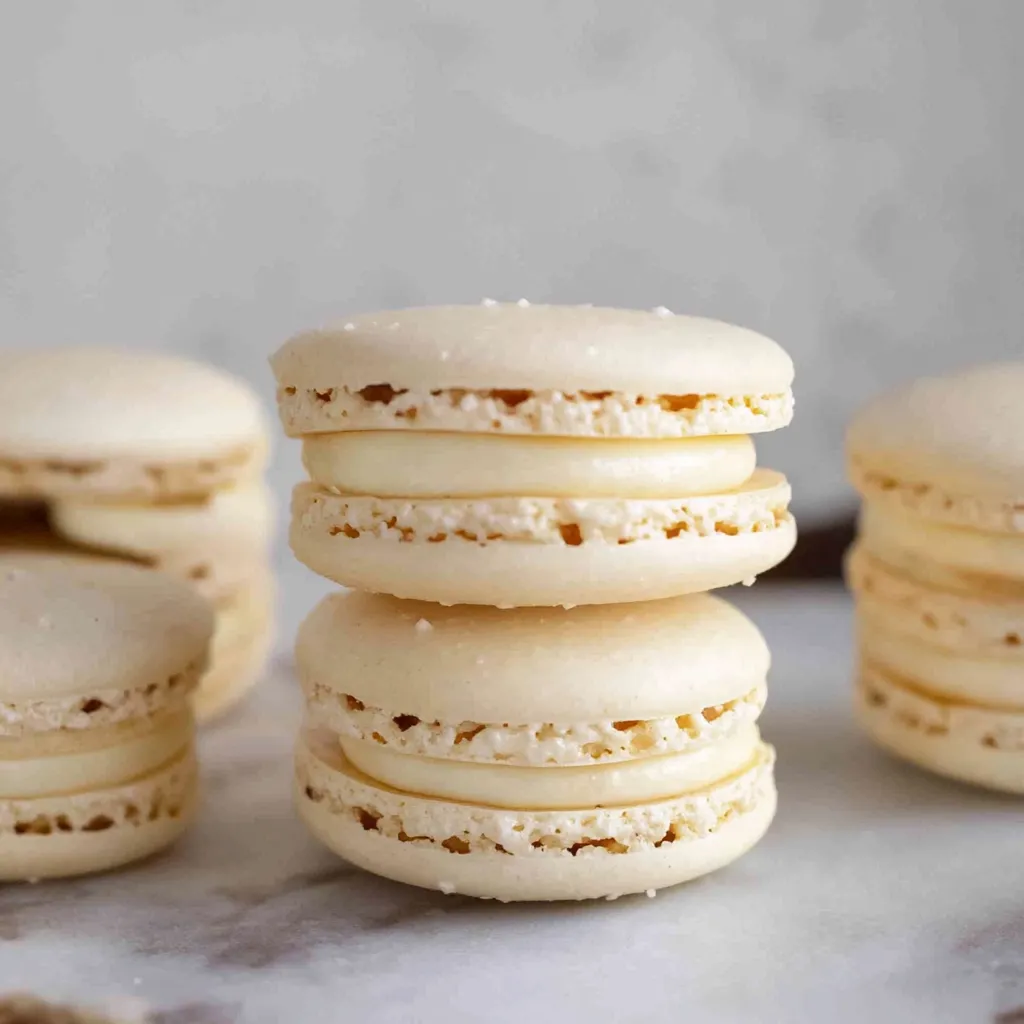 Pin it
Pin it
This vegan macaron recipe transforms the classic French delicacy into a plant-based treat that's just as delightful as the traditional version. The secret lies in aquafaba—the magical liquid from canned chickpeas—which creates the perfect meringue texture without eggs.
I spent nearly six months perfecting this recipe after a pastry chef friend challenged me to create vegan macarons. After countless failed attempts, this version finally achieves that distinctive macaron texture and appearance that even my non-vegan friends can't resist.
Ingredients
- Liquid from 2 cans of chickpeas: Prepared this way creates the perfect meringue base
- Cream of tartar: Helps stabilize the aquafaba whip
- Caster sugar: Provides the right texture and sweetness
- Ground almonds: Creates that distinctive macaron flavor
- Icing sugar: Contributes to the signature smooth shell
- Icing sugar: Provides sweetness and structure to the filling
- Vegan margarine: Creates a creamy texture without dairy
- Vanilla extract: Adds aromatic depth
- Plant-based milk: Adjusts consistency as needed
Step-by-Step Instructions
- Reduce the Aquafaba:
- Begin by weighing liquid from two cans of chickpeas (approximately 250g) and simmer until reduced by half to about 125g. This concentrates proteins essential for structure. Cool completely and refrigerate overnight in an airtight container for best results.
- Prepare Your Equipment:
- Preheat oven to 150°C/300°F (130°C/275°F fan). Line baking sheets with parchment paper. Ensure all bowls and utensils are absolutely clean and grease-free to allow proper whipping.
- Whip the Aquafaba:
- Place 100g reduced aquafaba in a clean bowl with cream of tartar. Whisk at high speed until frothy and pale. Gradually add caster sugar while continuing to whisk until the mixture becomes glossy white and holds stiff peaks. You should be able to invert the bowl without mixture moving.
- Create Dry Mixture:
- Sift ground almonds and icing sugar together thoroughly. Use the back of a spoon to work any larger pieces through the sieve for the smoothest possible texture.
- Combine Mixtures:
- Gently fold half the dry ingredients into whipped aquafaba using a spatula with a cutting motion. Add remaining dry ingredients and continue folding carefully until the batter reaches ribbon consistency. When lifted, batter should flow like lava and form a figure 8 without breaking.
- Pipe the Shells:
- Transfer batter to a piping bag fitted with a round tip. Pipe 2inch circles onto prepared baking sheets, leaving space between each. Firmly tap the trays against your work surface several times to release air bubbles.
- Rest the Shells:
- Allow piped macarons to rest at room temperature for 20 to 30 minutes until a skin forms. You should be able to gently touch the surface without batter sticking to your finger.
- Bake to Perfection:
- Bake in the middle of the oven for approximately 18 minutes. Shells are done when they feel stable when gently touched. Cool completely before removing from parchment.
- Prepare Buttercream:
- Mix icing sugar, vegan margarine, and vanilla until smooth. Beat with an electric mixer until light and fluffy, adding a splash of plant milk if needed for pipeable consistency.
- Assemble Macarons:
- Match shells of similar size. Pipe a small amount of buttercream onto the flat side of one shell and sandwich with another, gently twisting to spread filling evenly.
 Pin it
Pin it
My absolute favorite part of making these vegan macarons is watching guests' faces when I tell them they're made without eggs or dairy. My niece who has severe egg allergies cried the first time she was able to try a proper macaron at our family gathering last Christmas. These little treats are truly worth the effort.
The Science Behind Aquafaba
The chickpea liquid works because it contains proteins and starches that mimic egg whites remarkably well. Reducing the aquafaba concentrates these components, making it more stable when whipped. The overnight refrigeration further improves its performance by allowing proteins to settle and making the liquid more viscous.
Troubleshooting Tips
Hollow shells usually indicate the oven temperature was too high or baking time too short. An oven thermometer is essential for accurate temperature control. If shells crack during baking, your oven might be too hot or the macarons needed more resting time. Feet spreading outward typically means overmixed batter or insufficient resting time before baking.
Flavor Variations
Transform this basic recipe by adding natural food coloring to the meringue mixture after reaching stiff peaks. For flavored shells, incorporate a small amount of dry flavoring like matcha powder, freeze-dried fruit powder, or cocoa when sifting the dry ingredients. Adjust buttercream flavors with fruit preserves, nut butters, extracts, or even vegan chocolate ganache for endless creativity.
 Pin it
Pin it
Take your time and enjoy the process—it's worth the effort for these delicious vegan macarons!
Frequently Asked Questions
- → Why do I need to reduce the aquafaba?
Reducing the aquafaba concentrates its proteins, which helps create a more stable meringue structure that better mimics egg whites. This concentration is essential for achieving the signature macaron shell texture with the proper rise and foot formation.
- → How can I tell when my aquafaba is properly whipped?
Your aquafaba is properly whipped when it turns white and glossy with stiff peaks, meaning you can turn the bowl upside down without the mixture moving or falling out. This takes longer than with egg whites, so patience is key.
- → What is the perfect consistency for macaron batter?
The perfect macaron batter should flow like lava - when you lift some with a spatula and draw a figure 8, the batter should flow continuously without breaking. When piped, it should slowly flatten but maintain its circular shape without peaks.
- → Why do my macarons need to rest before baking?
Resting allows the macarons to develop a thin skin on top, which is crucial for proper rising in the oven. This skin helps force the batter to rise upward (creating the 'foot') instead of spreading outward during baking.
- → Why did my macarons crack during baking?
Cracking usually happens when macarons haven't rested long enough before baking, the oven temperature is too high, or the batter was undermixed. Ensure proper resting time, accurate oven temperature with a thermometer, and proper batter consistency.
- → Can I make these with different flavors?
Absolutely! You can add food coloring to the shell batter and incorporate different extracts or flavors into the buttercream filling. Popular variations include chocolate, lemon, coffee, raspberry, or pistachio.
